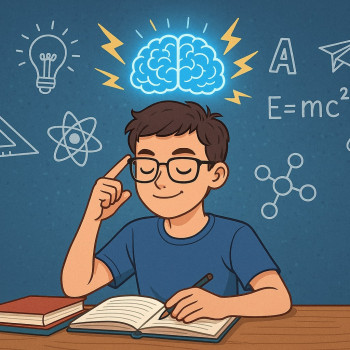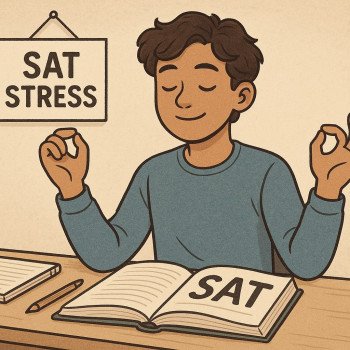How to Use AI Tools Wisely During SAT Prep
Introduction: Why this matters now
Welcome. If you’re reading this, you probably already know two things: the SAT is now digital and AI is everywhere. That gives you a huge advantage—when used thoughtfully. This blog is a practical, down-to-earth roadmap for how to use AI tools to boost your SAT score without falling into the traps of overreliance or shortcuts.
We’ll cover the smart ways to integrate AI into your study routine, show examples and comparisons to traditional prep, give concrete daily and weekly plans, discuss ethics and academic integrity, and point out when a human touch (like Sparkl’s personalized tutoring and tailored study plans) can make a major difference.
Big picture: AI as a study partner, not a replacement
Think of AI as a versatile study partner: a practice-generator, an explainer, a planner, and a feedback loop. It can create practice questions, turn mistakes into mini-lessons, and help you track progress. But it shouldn’t be the only voice in your prep. The SAT tests reasoning, timing, and endurance—things improved best through active practice, reflection, and targeted coaching.
How AI tools can help — and where they shine
1. Generating realistic practice questions
AI can produce targeted practice problems tailored to your weak areas—specific grammar rules, algebraic manipulations, or data interpretation skills. Instead of taking another full-length test when you don’t have time, ask an AI to generate 15–25 minute mixed-section practice sets that mimic Digital SAT pacing.
- Example: If your weak spot is data interpretation, ask the AI for 10 table- or graph-based questions with varying difficulty and a mix of multiple-choice and multi-select formats.
- Tip: Always time yourself and simulate test conditions so you get both accuracy and pacing feedback.
2. Explaining solutions clearly and efficiently
When you miss a question, a good AI can give an explanation that is step-by-step, or high-level depending on your preference. Ask it to explain in two ways: a one-sentence intuition and a detailed breakdown. This helps build both conceptual understanding and exam-style tactics.
- Example prompt to use: “Explain this problem in one sentence for intuition, then show the full solution with timing tips.”
3. Creating and refining study plans
AI planners can build a personalized, adaptive study schedule based on your test date, available hours per week, and target score. They’re great at rearranging tasks when life happens—if you need to shift a study block or refocus after a practice test, ask for an immediate, updated plan.
- Make the plan specific: include daily tasks, timed practice, review sessions, and rest days.
- Combine AI plans with human oversight—an experienced tutor (for example, Sparkl’s expert tutors) can tweak pacing, prioritize fundamental weaknesses, and help translate practice results into strategy changes.
4. Identifying patterns in your mistakes
AI that analyzes your practice-test results can spot recurring errors faster than you might alone—mix-ups on idioms, consistent algebraic slips, or timing breakdowns on multi-step reading questions. Use that insight to create micro-lessons focused on the root cause.
5. Building mental stamina with adaptive practice
The Digital SAT rewards focus and endurance. AI-driven adaptive drills can ramp difficulty as your performance improves, helping you build stamina without wasting time on problems that are too easy or too hard.
Where AI struggles — and why human guidance still matters
1. Nuance and strategy in reading and writing
The SAT reading and writing sections often hinge on subtle shifts in tone, purpose, or the most defensible answer—areas where AI explanations can sometimes be plausible but not test-aligned. Human tutors can offer exam-specific reasoning and share real test-taking instincts honed from experience.
2. Calibration for official scoring and test-feel
AI-generated questions vary in quality. Some may not match the exact phrasing or difficulty distribution of official SAT items. That’s why it’s essential to supplement AI practice with official practice materials and, when possible, with human review that keeps your prep aligned with what the College Board expects.
3. Accountability and emotional support
Studying is part technical and part emotional. A tutor or accountability partner provides encouragement, helps manage test anxiety, and offers perspective after a disappointing test—something AI cannot fully replicate. That’s a natural place for Sparkl’s personalized tutoring to fit: one-on-one guidance, tailored plans, and experienced tutors who help you recover and pivot after tough practice tests.
Practical, step-by-step routine: 12-week AI-enhanced plan
Below is a sample 12-week plan that blends AI tools with focused human oversight. Adjust depending on your base level and target score.
Weeks 1–2: Diagnostic and foundation
- Take an official full-length Digital SAT diagnostic under timed conditions (use Bluebook or a school-administered test simulation).
- Feed your results into an AI analysis tool or upload question logs and ask the AI to create a mistake profile (concepts missed, pacing, question types).
- Create a 6-day weekly routine: two focused concept sessions, two mixed-practice blocks, one timed-section practice, and one full-review day.
Weeks 3–6: Skill-building and targeted practice
- Use AI to generate targeted question sets for your top three weaknesses—25–40 questions per week per weakness.
- After each set, ask the AI for a one-paragraph summary of recurring errors and one strategy to fix each type of mistake.
- Schedule a weekly 1-hour check-in with a tutor or mentor to review strategies and get human feedback; Sparkl’s expert tutors can provide tailored adjustments and realistic pacing advice during these sessions.
Weeks 7–10: Simulation and refinement
- Take a full-length official practice test every 10–14 days. Between tests, run focused drills where AI increases difficulty until accuracy drops below your target threshold, then back off and re-teach the concept.
- Practice test review: use AI to produce a mistake heat map, then prioritize the top five error types for the next two weeks.
- Refine timing with AI-generated timed mini-sections (20–35 minutes) to simulate digital question flow.
Weeks 11–12: Final polishing and test readiness
- Reduce new learning; emphasize consolidation: short, high-quality practice sessions, sleep, and mental prep.
- Use AI to create quick review sheets with the most frequently missed rules and formulas customized to your errors.
- Schedule a final session with a tutor to run through test-day strategy, pacing, and confidence-building routines.
Day-to-day micro-routines that actually work
Not everyone can study 3–4 hours a day. Here are short, focused routines you can use on busy days.
20-minute deep dive (concept repair)
- 5 minutes: warm-up question (AI-generated) on the concept.
- 10 minutes: error analysis—ask the AI to explain the mistake and present two alternate solution methods.
- 5 minutes: one new question and immediate review.
40-minute timing drill (pacing focus)
- 30 minutes: timed mixed-section mini-test from AI (or official short set).
- 10 minutes: quick review of timing errors and one pacing adjustment for next session.
Ethics, integrity, and sensible boundaries
Using AI responsibly isn’t just about getting better results; it’s about preparing honestly so your score reflects your true abilities. Colleges and scholarship programs expect that your scores represent your work.
Do: Use AI for practice creation, explanation, planning, and review.
Don’t: Use AI to generate answers during an actual test, impersonate you, or submit AI-written essays as your personal work without understanding every line.
- If you use AI to brainstorm essay ideas, always rewrite in your own voice and confirm you can discuss every point you include.
- Keep logs of your practice sets and notes so your progress is transparent and reviewable by any human tutor or mentor.
Comparisons and examples: AI vs. classic methods
Here are side-by-side comparisons to help you decide when to use AI and when to stick with classic methods.
| Task | AI-driven approach | Classic human approach | Best use |
|---|---|---|---|
| Practice question generation | Instant, tailored sets by topic and difficulty | Using official College Board practice tests and prep books | Blend both: use AI for focused drills, official materials for calibration |
| Explanations | Fast step-by-step or intuition-first explanations | Tutor-led, with edge-case insights and strategy | AI for quick fixes; tutors for deep conceptual gaps |
| Study planning | Adaptive, can rework plans instantly | Human-created schedules with accountability | AI plans plus weekly tutor check-ins |
| Scoring and calibration | Can approximate difficulty and error patterns | Official scoring and expert interpretation | Use official scoring to validate AI results |
How to evaluate AI feedback quality
All AI outputs are not created equal. Here’s a quick checklist to evaluate whether an AI response is helpful and test-appropriate.
- Does the explanation match the official answer when you compare it to practice tests? If not, question it.
- Is the reasoning aligned with SAT-style strategies (process of elimination, inference from context, algebraic simplification)?
- Does the AI provide a clear, test-friendly shortcut or is it overcomplicating a simple step? Prefer simpler, reproducible strategies.
- Can you explain the AI’s solution in your own words? If you can’t, don’t rely on it yet—ask for a simpler breakdown.
When to bring in human help (and how to do it efficiently)
You don’t need a tutor for every question, but there are high-leverage moments where an expert saves weeks of wasted effort.
- Plateaus: If your score stalls after several weeks, a tutor can diagnose subtle issues—timing habits, test anxiety, flawed strategy—that AI misses.
- Deep conceptual gaps: For repeated algebra or syntax mistakes, an expert can re-teach foundational ideas in new ways.
- Final weeks: A human coach helps with pacing, mental prep, and triage of last-minute issues. Sparkl’s personalized tutoring pairs human insight with AI-driven practice plans for an efficient final sprint.
Test-day checklist when you used AI to prep
- Device setup: If you’re using your own device in test mode, practice on the same device and app (Bluebook or your school’s approved software) to avoid surprises.
- Materials: Bring required ID and any approved accessories. Don’t rely on AI during the test—this is closed-book, timed, and proctored.
- Mindset: Remember that AI helped sharpen your skills; on test day, trust your practiced strategies and pacing routines.
Final tips — small habits that compound
- Daily reflection: Spend 5 minutes each day listing one error type you won’t repeat tomorrow.
- Speak aloud: Explain solutions out loud to a friend or your phone—teaching is one of the fastest ways to learn.
- Calibration sessions: Monthly, take an official full-length test to check that AI practice matches real performance.
- Balance: Use AI to accelerate learning, but keep time for timed practice and human feedback.
Why combining AI and personalized tutoring works best
AI scales certain tasks—question generation, instant explanations, adaptive pacing—beautifully. Human tutors bring judgment, experience, and emotional support. When you pair AI-driven efficiency with one-on-one guidance, you get a study system that adapts, corrects course, and builds confidence. That’s the best route to a strong, trustworthy Digital SAT score.
For example, Sparkl’s personalized tutoring model uses expert tutors to interpret AI-driven diagnostics and convert them into actionable, student-friendly strategies: targeted lessons, pacing drills, and confidence-building sessions. That human translation is often the missing piece between doing more practice and actually improving your score.
Closing thoughts: Make AI your tool, not your crutch
AI can dramatically shorten the path to improvement if you use it with curiosity, skepticism, and structure. Treat AI like a knowledgeable study partner—ask clear questions, demand explanations you understand, and always validate practice against official materials.
Most importantly, keep humans in the loop. A tutor or mentor who checks your plans, corrects misaligned strategies, and supports you through dry patches will multiply the value you get from AI. Blend the speed of smart tools with the wisdom of experienced teachers, and you’ll arrive on test day prepared, calm, and ready to perform.
If you take one thing away
Use AI to practice smarter: personalize drills, get clear explanations, and adapt your plan—but pair it with official practice and human feedback so your score truly reflects your abilities. With that balance, you’ll be turning technology into tangible improvement, one practice set at a time.
Good luck—and remember: steady, thoughtful practice beats frantic cramming every time.














No Comments
Leave a comment Cancel